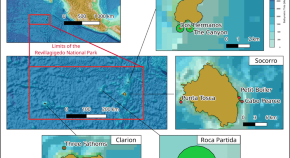Movement patterns and residency of silvertip sharks (Carcharhinus albimarginatus) in a remote archipelago of the Eastern Tropical Pacific
Authors (first, second and last of 6)

Collection
We are pleased to announce a Special Issue of Environmental Biology of Fishes highlighting the most recent research completed in elasmobranch ecology.
In this Special Issue, we encourage submissions that present new knowledge, utilizing the most advanced techniques, on the behavioral, ecological, population, and conservation biology of sharks and rays. Manuscripts can be original research or review articles, following the submission guidelines for Environmental Biology of Fishes articles.
Authors can submit manuscripts to be considered for this Special Issue by clicking on the Submit manuscript button and using the Editorial Manager procedure on the journal website. At the time of submission, authors will be asked if their manuscript belongs to a Special Issue, upon which they can select SI: Elasmobranch Biology.
All manuscripts will be considered on their own merits for review and eventual rejection or acceptance following standard journal procedures. Individual manuscripts will be published electronically online as soon as they are accepted. All accepted manuscripts will then be assembled and published as a Special Issue in one of the journal's print issues.
Dr. A. Peter Klimley has studied animal behavior for over four decades. He received a MS in oceanography from the Rosenstiel School of Marine and Atmospheric Science at the University of Miami, Florida, and a PhD in marine biology from Scripps Institution of Oceanography of the University of California, San Diego. He has just retired from the positions of Director of the Biotelemetry Laboratory and Adjunct Professor in the Department of Wildlife, Fish, and Conservation Biology at the University of California, Davis, where he served as mentor of many graduate students in Animal Behavior, Ecology, and Geography Graduate Groups.
Dr. Dean Grubbs is a fish ecologist studying the biology and ecology of sharks and rays in coastal, pelagic, and deep-sea environs. He received his PhD from the Virginia Inst. of Marine Science in 2001 and was a post-doc fellow and research faculty at the Hawaii Inst. of Marine Biology. Since 2007, he has been at the Florida State University Coastal and Marine Laboratory, where he maintains an active and highly collaborative lab and mentors graduate and undergraduate students as a Research Professor and the Associate Director of Research. Dean also serves on numerous advisory panels and is a Scientific Advisor to the Save Our Seas Foundation.
Dr. María Cristina Oddone has studied elasmobranch biology for over 25 years. She received an MS in biological oceanography from the Instituto de Oceanografia, Universidade Federal do Rio Grande (FURG) in Brazil, and a PhD in zoology from the Universidade Estadual Paulista Júlio de Mesquita Filho. She is now an Adjunct Professor at the Instituto de Ciências Biológicas at FURG, where she founded and leads the Laboratório de Pesquisa em Chondrichthyes, acts as curator of the chondrichthyan collection, and mentors graduate and postgraduate students in developmental biology and embryology, reproduction, taxonomy, morphology, and conservation.
Dr. Ricardo Rosa has studied elasmobranch biology since 1979, initially focusing on the systematics of stingrays and later on the ecology and conservation of sharks. He received a PhD in marine science from the Virginia Inst. of Marine Science in 1985. He served as a professor at Federal University of Paraiba in Brazil, where he directed the graduate program in Biological Sciences and the Department of Systematics and Ecology. He is now retired from that position but still mentors graduate students. He acted as editor or member of editorial commissions in several biological sciences journals, and as major professor of 60 graduate students.
Dr. Guy Stevens has spent the last 20 years studying manta and devil rays (mobulids) all over the world. After completing a degree in Marine Biology and Coastal Ecology at the University of Plymouth in the UK, Guy moved to the Maldives, where he founded the Maldivian Manta Ray Project in 2005. He completed his PhD on the world’s largest population of reef manta rays in 2016, and he is now the Chief Executive and Founder of the Manta Trust, a UK registered charity dedicated to the conservation of manta and devil rays, with collaborative projects in over 25 countries.
Dr. Nerea Lezama-Ochoa is a spatial marine ecologist and an Assistant Project Scientist at the Ecosystem Climate Division (NOAA, Monterey, USA) specializing in large pelagic species. She has a PhD in Fisheries and Conservation from AZTI (Spain) and completed a postdoc at the Inter-American Tropical Tuna Commission (San Diego, USA). Her research focuses on the conservation and management of pelagic species taken incidentally in fisheries. Her main research interests are ecological modeling, spatial ecology, oceanography, and ecosystem-based management approaches for the conservation of marine top predators.
Dr. Joshua Stewart is an Assistant Professor at the Oregon State University Marine Mammal Institute. He is a quantitative marine ecologist whose interests span animal movement, trophic ecology, and population dynamics with an emphasis on threatened species and ecosystems. A major focus of his work has been the ecology and conservation of manta and devil rays, and he has been an Associate Director and science advisor for The Manta Trust since its inception in 2011. He has a strong interest in applied science, collaborating with stakeholders and managers, and applying research findings directly to management with input from resource users.
Dr. Melissa Cronin is a Smith Conservation Research Fellow and postdoctoral researcher hosted by the Coasts and Commons Co-Laboratory at Duke University. Her research focuses on understanding the impacts of industrial fishing on threatened species, particularly sharks and rays, and on human coastal communities. She is co-founder and Ecuador Director of Mobula Conservation Project, an organization dedicated to the research and conservation of manta and devil rays in the Eastern Pacific Ocean.
